How to Check Your Dishwasher Drain Connection
Before we tackle the problem of why dishwasher not draining, it’s important to understand what is your dishwasher’s drain connection. There are several types, each with its unique considerations:
Garbage Disposal Connection: Common and Convenient
Many modern dishwashers are connected to a garbage disposal unit, facilitating efficient drainage. Here’s how it works: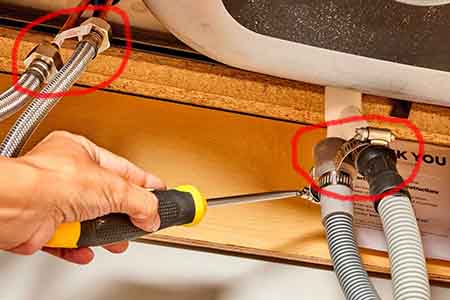
- Wastewater from the dishwasher is pumped into the garbage disposal.
- Inside the disposal, it’s broken down and then emptied through the plumbing.
- This setup is prevalent in modern kitchens, offering a convenient way to manage dishwasher drainage.
Air Gap Connection: Preventing Contamination
Some dishwashers use an air gap to prevent sink water from flowing back into the dishwasher. Here’s what you need to know:
- An air gap is a device that ensures wastewater exits the dishwasher and enters the drainage system.
- It creates a physical barrier, preventing any contamination from the sink.
- This feature is recommended in areas with strict plumbing codes.
High Loop Installation: Effective Contamination Prevention
Certain dishwasher systems employ a high loop in the drain pipe to prevent sink water from re-entering the dishwasher. Here’s how it works:
- The high loop raises the drain hose above the sink, ensuring water cannot flow back.
- While simpler than an air gap, it’s equally effective at preventing contamination.
Direct Drainage to Sink Trap: Simplicity in Older Homes
In older homes, dishwashers may have a direct connection to the sink’s plumbing trap. Here’s what you should know:
- Wastewater flows directly from the dishwasher into the sink’s trap.
- From there, it enters the drain system.
- This straightforward setup can work effectively when properly maintained.
Common Dishwasher Drain Issues
Supplies
To start this task of eliminating unpleasant odors, make sure you have the necessary supplies and tools to effectively address both dishwasher odors and drainage problems.
Supplies:
- Baking soda: is a versatile and naturally occurring cleaning agent that possesses a wide range of uses.

- White vinegar: A powerful odor remover and cleaner.
- Soft brush or toothbrush: Ideal for scrubbing hard-to-reach areas.
- Screwdriver: Necessary for disassembling certain dishwasher parts.
- Dishwasher Detergent: Select a high-quality dishwasher detergent to achieve the best cleaning results.
- Rubber gloves: Protect your hands during maintenance tasks.
Tools:
- A bucket: Handy for collecting water and debris.
- A clean cloth or sponge: Used for wiping and cleaning.
- A flashlight (optional): Helps you inspect hidden areas within the dishwasher.
Now, let’s explore the common causes and solutions behind a dishwasher that’s not draining as it should:
1. Clogged Drain Hose
Causes:
- Food Debris: Food debris can clog the drain hose by entering the dishwasher’s drainage system. These impurities may build up over time and obstruct the correct flow of water.
- Improper Dish Scraping: Not scraping excess food from dishes before loading them into the dishwasher can result in larger food particles entering the drainage system, eventually causing a clog.
- Foreign Objects: Occasionally, non-food items like small utensils or pieces of plastic can accidentally make their way into the dishwasher, causing obstructions in the drain hose.
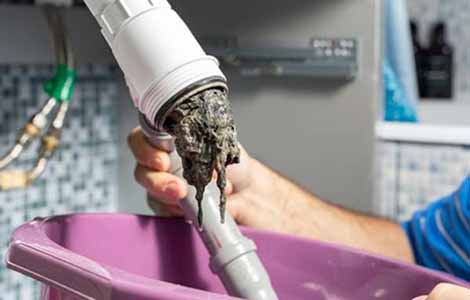
Solution:
- Disconnect the Dishwasher: Safety first. Before attempting any repairs, disconnect the dishwasher from the power source. You can unplug it or turn off the circuit breaker.
- Inspect the Drain Hose: Look for any visible blockages or kinks in the drain pipe by carefully inspecting it. Locate the drain system connection point by following the dishwasher’s hose there.
- Remove Blockages: If you come across any impediments or debris, remove them gently. To reach and remove obstructions, you can use a long brush, a pipe cleaner, or even a bent coat hanger. Make sure the hose is unobstructed and clear.
- Reconnect the Drain Hose: After clearing any obstructions, securely reconnect the drain hose to both the dishwasher and the drain point. Ensure there are no kinks or sharp bends in the hose.
- Test the Dishwasher: Plug the dishwasher back in or turn on the circuit breaker. Run a test cycle to verify that the drainage issue is resolved. During the cycle, monitor the drainage to confirm that water flows freely.
2. Blocked Garbage Disposal
Cause: Problems with drainage can result from a clogged garbage disposal.
Solution:
- Turn off the power to the garbage disposal. Always prioritize safety when dealing with appliances connected to electricity. Locate the garbage disposal unit and turn it off using its power switch or by unplugging it.
- Inspect the disposal for any clogs or obstructions. Look inside the disposal chamber for any debris that might be causing a blockage. Use a flashlight to get a clear view of the inside.
- Remove any obstructions you discover, and make sure the disposal works properly. Using a long tool like a wooden spoon or a plunger, gently dislodge any debris inside the disposal. Ensure that the disposal blades can move freely.
- Restart the dishwasher to check if it drains correctly. Once you’ve cleared the disposal, turn it back on or plug it in. Run a dishwasher cycle to verify that the drainage issue is resolved. Keep a close eye on the drainage during the cycle to confirm that the problem is fixed.
3. Dishwasher Air Gap Problems
Cause: Drainage may be hampered by a problem with the air gap device in the dishwasher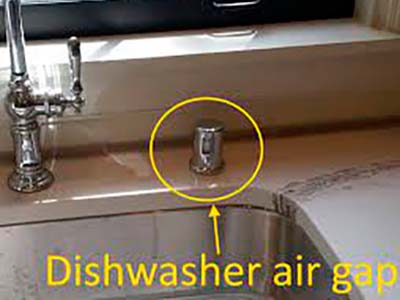
Solution:
- To check for obstructions or debris, remove the air gap cover. The air gap cover is often attached to the dishwasher’s drain hose and is situated on your sink or countertop.
- Clean the air gap thoroughly, ensuring there are no obstructions. Use a small brush, like a bottle brush, or a pipe cleaner to clear any debris from inside the air gap. Rinse it with warm water to ensure it’s clean.
- Run a test cycle to verify improved drainage. After cleaning the air gap, run a dishwasher cycle to check if the drainage problem is resolved. Keep an eye on the drainage to ensure it’s functioning correctly.
4. Drain Pump Malfunction
Cause: The drain pump plays a critical role in removing water at the end of each dishwasher cycle. If this component malfunctions, it can disrupt proper drainage.
Solution:
- Inspect the Drain Pump: Begin by carefully examining the drain pump for any visible damage or irregularities. Pay close attention to the wiring and connections to ensure they are secure and undamaged.
- Check Wiring and Connections: Look for loose or disconnected wires around the drain pump. If you find any issues, consider tightening or reattaching them as needed. Ensure that all electrical connections are secure.
- Inspect for Physical Damage: Examine the pump for any signs of wear, physical damage, or cracks. To access the drain pump, which is typically located at the dishwasher’s base, you may need to remove the front panel. Make sure there are no obstructions blocking the pump’s operation.
- Test the Drain Pump: If you suspect that the drain pump is faulty, you can check its electrical resistance using a multimeter. This will help determine if the pump is functioning correctly. For detailed instructions on testing the drain pump, consult your dishwasher’s manual or seek professional advice.
- Consult a Professional: Replacing a drain pump can be a complex task and is often best handled by a qualified technician. If you have determined that the pump is the root cause of the drainage issue, it’s advisable to contact a professional for repair or replacement.
5. High Loop Installation
Causes: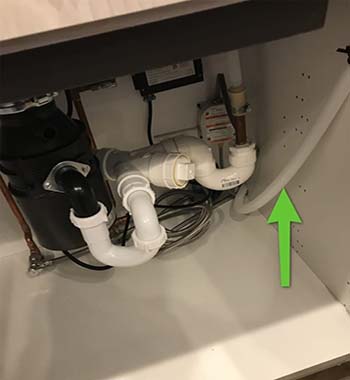
- Improper Installation: The primary cause of a high loop installation issue is incorrect or improper installation during the initial setup of the dishwasher. This may occur during a new installation or when the dishwasher has been moved or disconnected for maintenance.
Solutions for High Loop Installation Issues:
- Verify High Loop Placement: Check that the high loop, which prevents water from entering the dishwasher again, is properly placed. The high loop should be installed higher than the rim of the sink. This positioning is crucial to prevent backflow of water into the dishwasher.
- Secure the Drain Hose: Ensure that the drain hose is securely fastened to prevent sagging. Make sure the drain hose is properly attached to both the dishwasher and the drainage point (usually the sink or disposal unit). Check for any sagging or loose connections that could compromise drainage.
- Adjust the High Loop: If you find that the high loop is not correctly positioned, carefully adjust it to the appropriate height. The goal is to create a barrier that prevents sink water from flowing back into the dishwasher. Secure the loop in its elevated position.
- Consider Professional Help: If you’re unsure about how to correctly install or adjust the high loop, or if it requires significant modifications, consider seeking assistance from a professional appliance technician. They have the expertise and tools needed to ensure proper installation.
- Maintenance Check: Periodically inspect the high loop and the drain hose connections to ensure they remain secure and in the correct position. Regular maintenance checks can prevent drainage problems from occurring in the future.
6. Dishwasher Filter Clogs
Cause: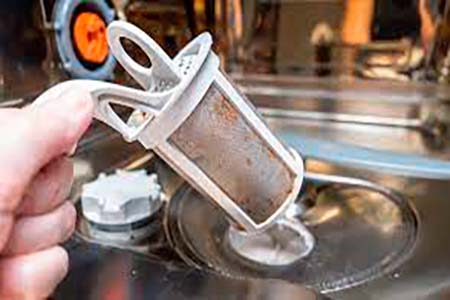
- Accumulation of Food Debris: One of the primary causes of dishwasher filter clogs is the accumulation of food particles and debris over time. When dishes aren’t rinsed thoroughly before loading or when the dishwasher filter is not cleaned regularly, these particles can block the filter and restrict water flow.
Solutions:
- Locate and Remove the Filter: Find the dishwasher filter, which is typically located near the base of the appliance. Refer to your dishwasher’s manual for the exact filter placement. Most often, it’s positioned near the spray arm in the lowest part of the dishwasher.
- Thoroughly Clean the Filter: Remove the filter carefully and clean it thoroughly. Use a soft brush or a cloth to dislodge and remove any food particles that may have become lodged inside. Cleaning the filter helps maintain proper water flow and drainage.
- Reassemble and Test: After cleaning the filter, reassemble it according to your dishwasher’s instructions. Ensure it’s securely in place. Run a full dishwasher cycle to test whether the drainage issue has been resolved. Properly cleaned filters enhance dishwasher performance.
7. Damaged Drain Solenoid
Causes:
- Mechanical Wear and Tear: Over time, the drain solenoid, responsible for operating the drain valve, can experience mechanical wear and tear. This wear can result from the constant opening and closing of the drain valve during dishwasher cycles.
- Electrical Malfunction: Electrical issues, such as short circuits or damaged wiring, can also lead to a malfunctioning drain solenoid. These issues may prevent the solenoid from functioning properly, hindering drainage.
Solutions for Damaged Drain Solenoid:
- Inspect for Physical Damage: Begin by inspecting the drain solenoid for any obvious physical blemishes. Look for cracks, exposed wires, or other visible signs of damage. If you notice any of these issues, the solenoid may need replacement.
- Test Solenoid Functionality: If there are no visible signs of damage, you can check the solenoid’s functionality using a multimeter. Measure the solenoid’s electrical resistance with the multimeter to determine if it’s working within the expected parameters.
- Professional Replacement: If the drain solenoid is confirmed to be malfunctioning or damaged, it’s advisable to seek professional assistance for replacement. Replacing a drain solenoid valve can be a complex task and is typically best performed by a qualified technician.
Preventing Dishwasher Drain Problems
Preventive measures can increase the lifespan of your device for a long time keeping your dishwasher’s drainage system in optimal condition. Here are some tips to prevent dishwasher drain problems:
Regular Maintenance Tips
- Clean the Filter: To avoid obstructions and guarantee effective drainage, the dishwasher’s filter should be cleaned on a regular basis. The filter should be taken out, carefully rinsed, and then reinstalled.
- Check the Drain pipe: Occasionally look for kinks, damage, or obstructions in the drain pipe. Make sure it is firmly fastened to the drain point and the dishwasher
- Clean the Air Gap: Keep the air gap clean and free from debris to maintain proper drainage. Remove the air gap cover, clean it, and ensure its reinstalled securely.
Proper Dishwashing Practices
- Scrape Dishes: Before loading dishes into the dishwasher, scrape off large food particles into the trash. Modern dishwashers are designed to handle dirty dishes without pre-rinsing, so avoid excessive rinsing.
- Load Dishes Properly: Avoid overloading the dishwasher, as overcrowded dishes can obstruct water flow and affect drainage. Follow the manufacturer’s guidelines for proper loading.
Choosing the Right Dishwasher Detergent
The type of detergent you use can impact drainage, as excessive suds or detergent residues can hinder the flow of water. Here are some key points to consider when choosing the right dishwasher detergent:
- Detergent Formulation: Dishwasher detergents come in various formulations, including powder, gel, and tabs. Each has its advantages. Powder detergents are known for their versatility, while gel detergents are easy to use. Detergent tabs offer convenience but can be pricier.
- Phosphate-Free Detergents: Many regions have banned dishwasher detergents containing phosphates due to environmental concerns. Opt for phosphate-free detergents, which are safer for the environment and still provide excellent cleaning results.
- Enzyme-Based Detergents: Look for detergents that contain enzymes. These enzymes help break down and remove food residues effectively, improving both cleaning performance and drainage.
- Low Suds Formula: Excessive suds can impede the dishwasher’s performance and drainage. Choose a dishwasher detergent with a low suds formula to prevent suds-related issues.
- Detergent Dosage: Follow the manufacturer’s recommendations for detergent dosage. Using too much detergent can lead to excess suds, which can affect drainage. Using too little may result in subpar cleaning.
- Rinse Aid Compatibility: Consider using a rinse aid in conjunction with your dishwasher detergent. Rinse aid helps dishes dry more efficiently, reducing the risk of water spots. It can also improve drainage by allowing water to flow off dishes more easily.
With these considerations in mind, you’ll be able to choose a dishwasher detergent that not only delivers sparkling clean dishes but also supports optimal dishwasher performance and drainage.
How to Prevent Dishwasher Clogs
In addition to drainage issues, dishwasher clogs can be a common headache. Here are some preventive tips:
- Use Rinse Aid: Incorporate rinse aid into your dishwasher routine to improve drying performance and prevent water spots on dishes and glassware. Rinse aid helps water sheets off dishes, ensuring they dry more effectively.
- Regularly Clean the Spray Arms: Consistently clean the spray arms on the dishwasher to make sure they revolve freely and effectively distribute water. Drainage and cleaning may be hampered by clogs in the spray arms.
- Run Hot Water First: Before starting your dishwasher, run hot water from the sink tap until it’s hot. This ensures that your dishwasher begins the cycle with the right temperature for optimal cleaning and drainage.
By following these preventive measures and troubleshooting steps, you can keep your dishwasher running smoothly and efficiently
Stay tuned for more helpful guides and maintenance tips as we continue to empower you with knowledge to maintain your household appliances. With these insights, you’ll keep your dishwasher in top shape and avoid the hassle of drainage issues in the future.